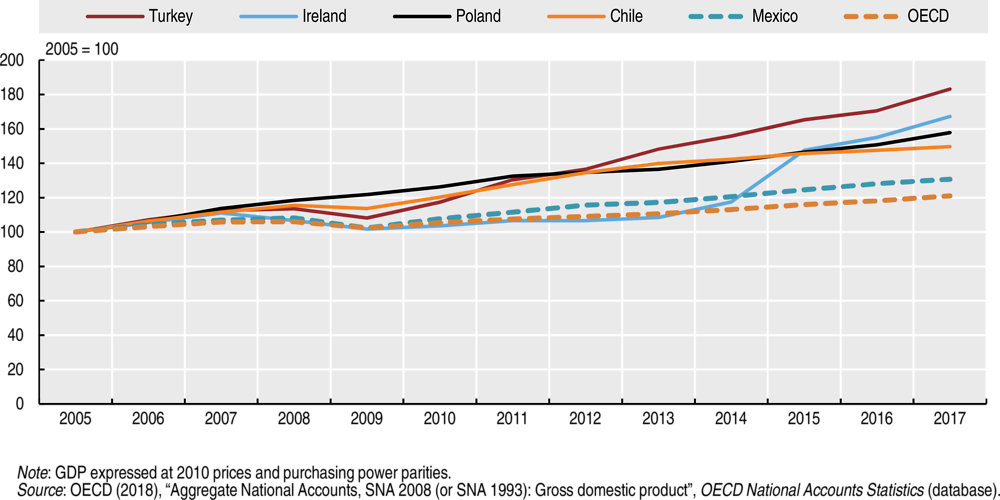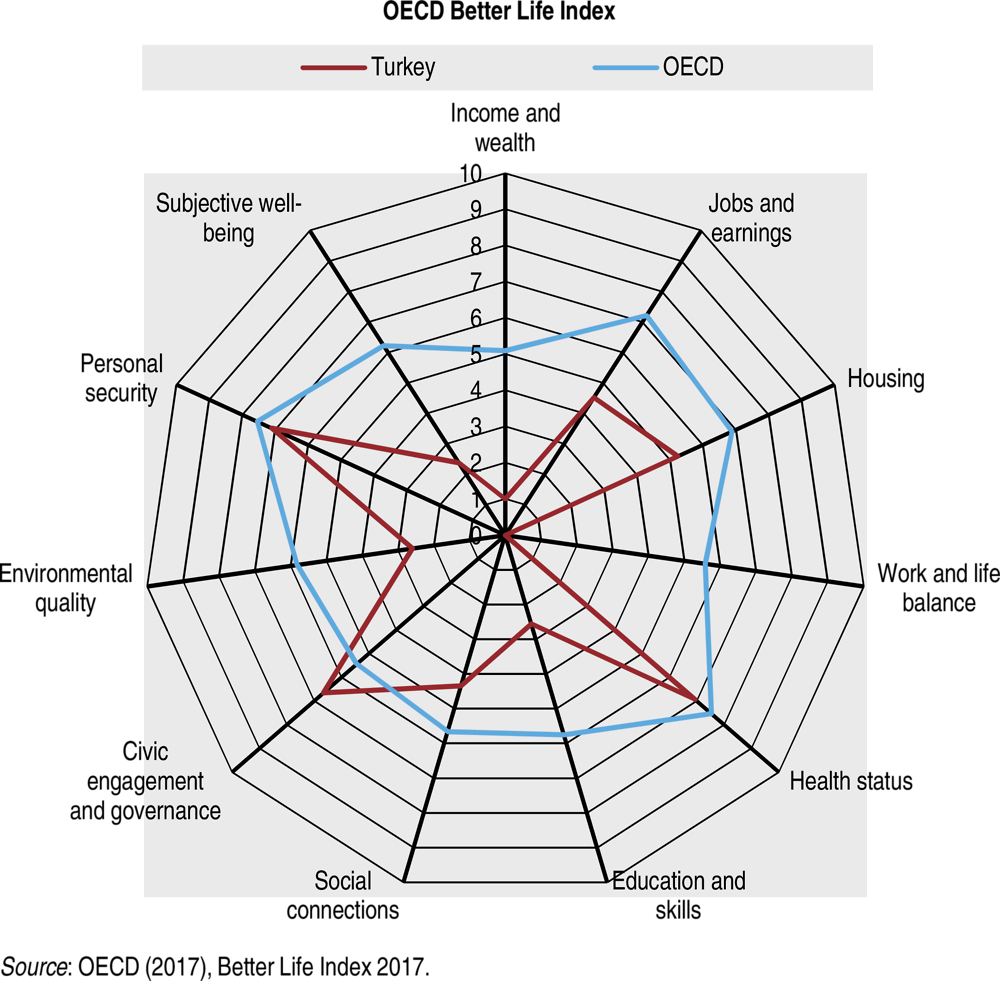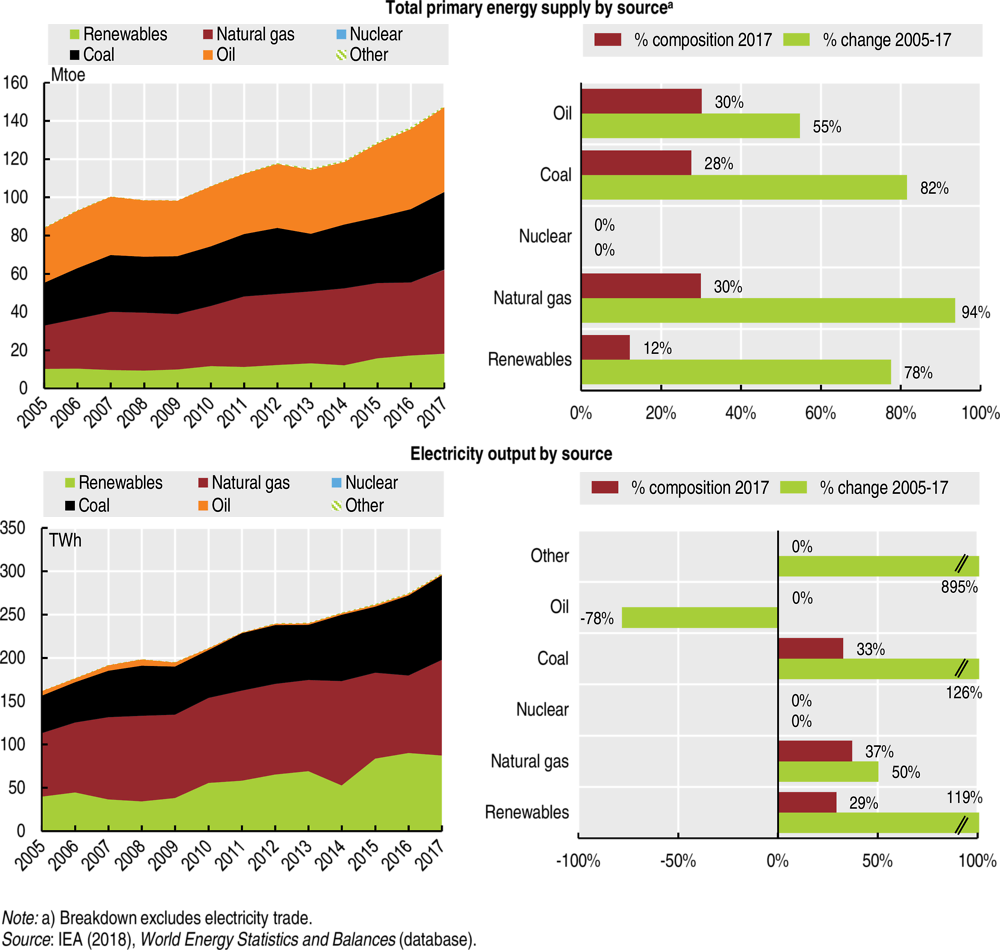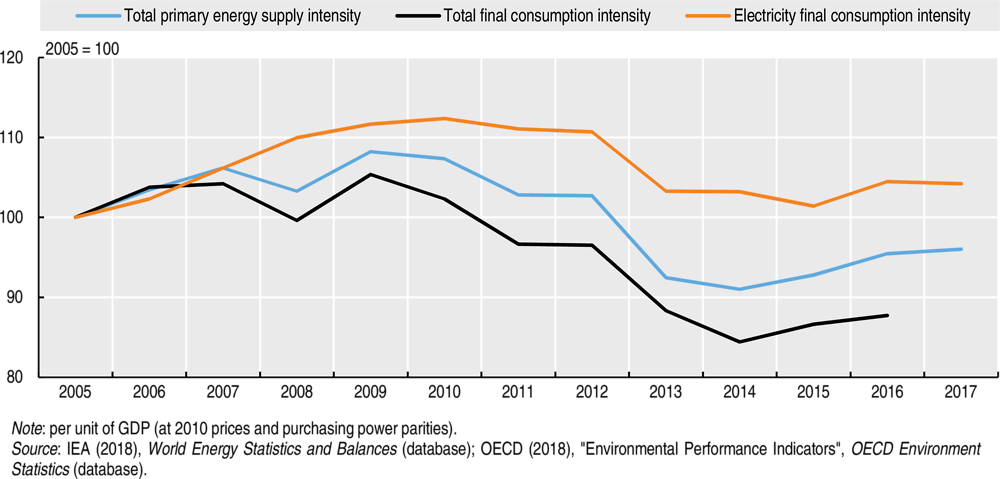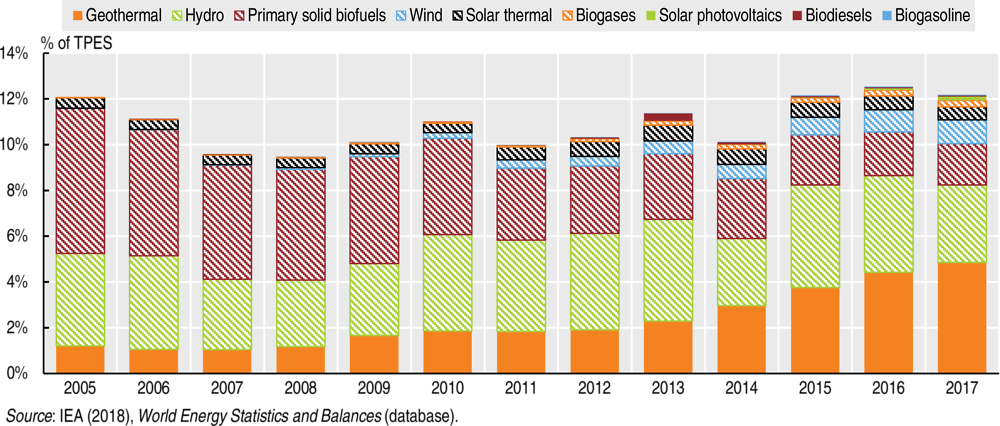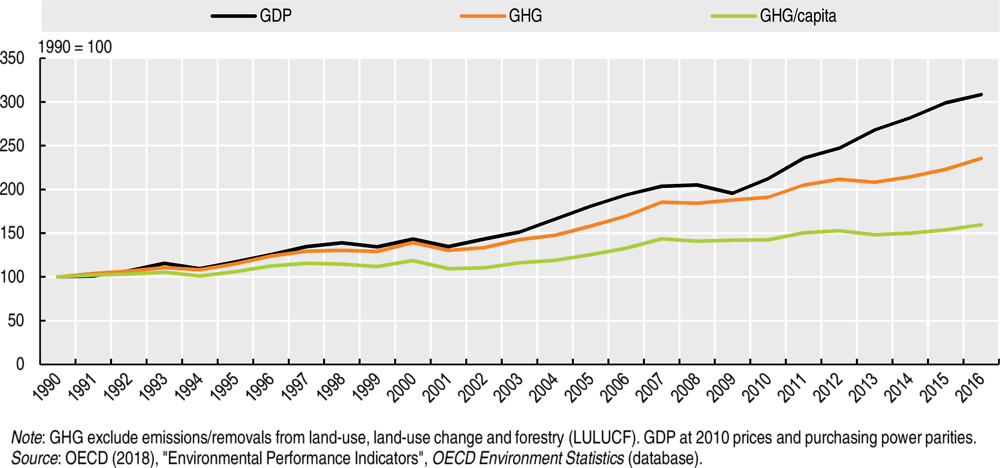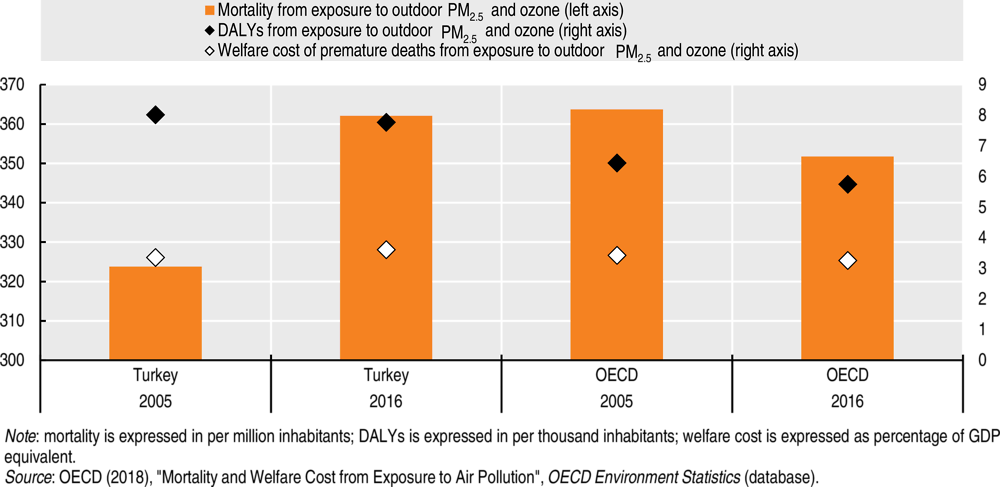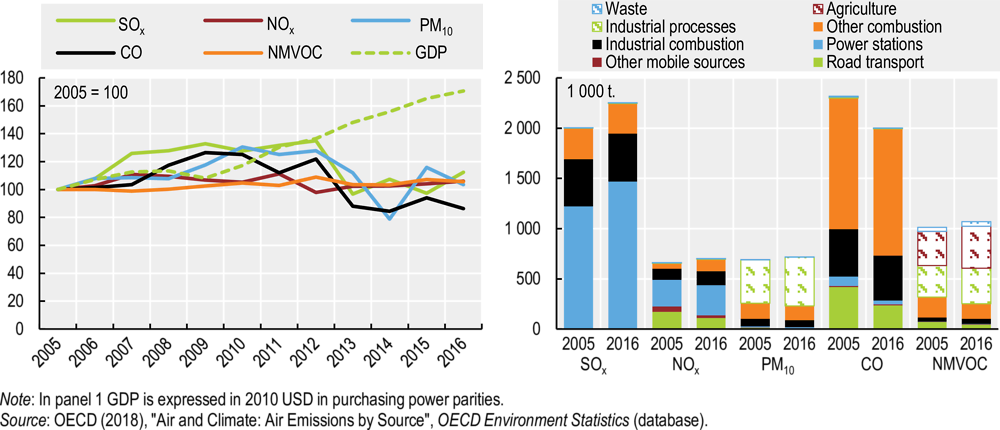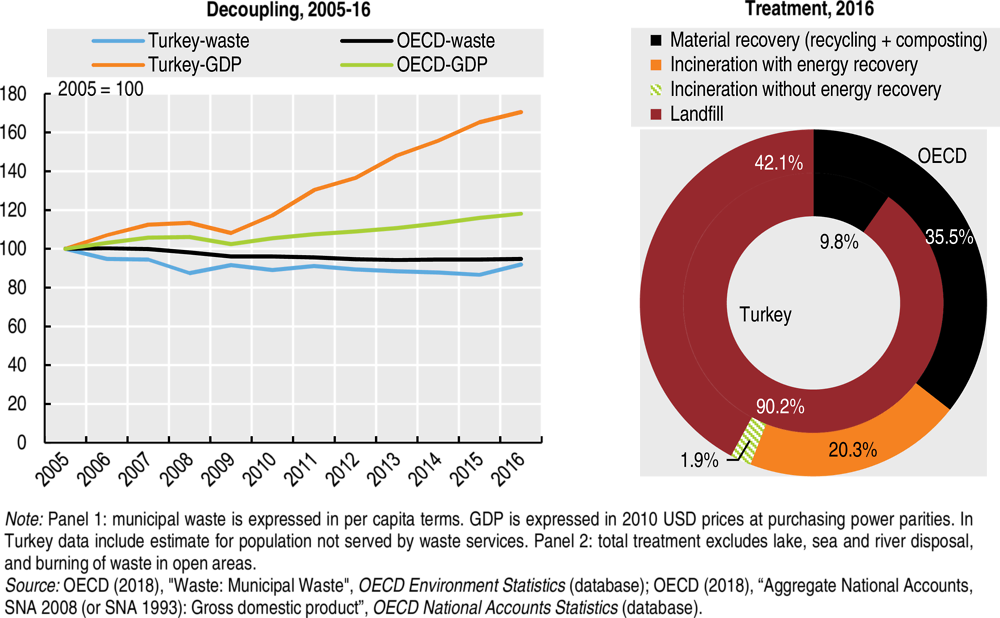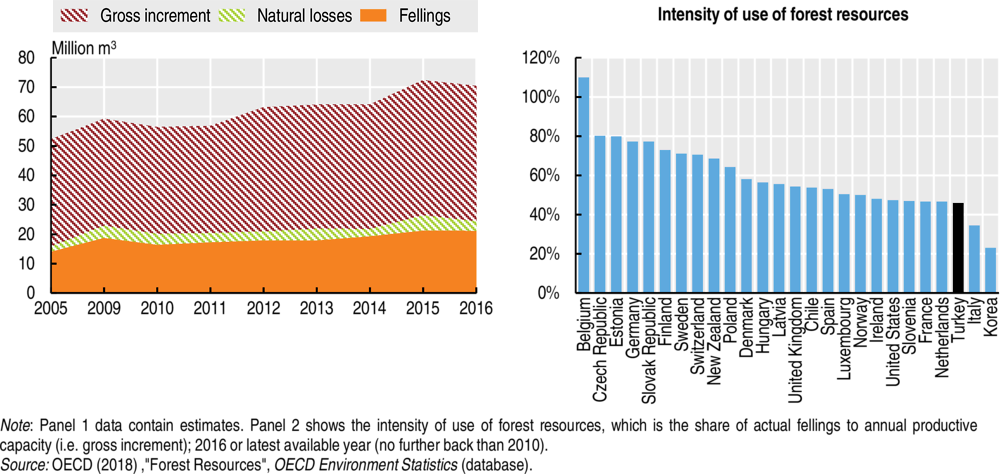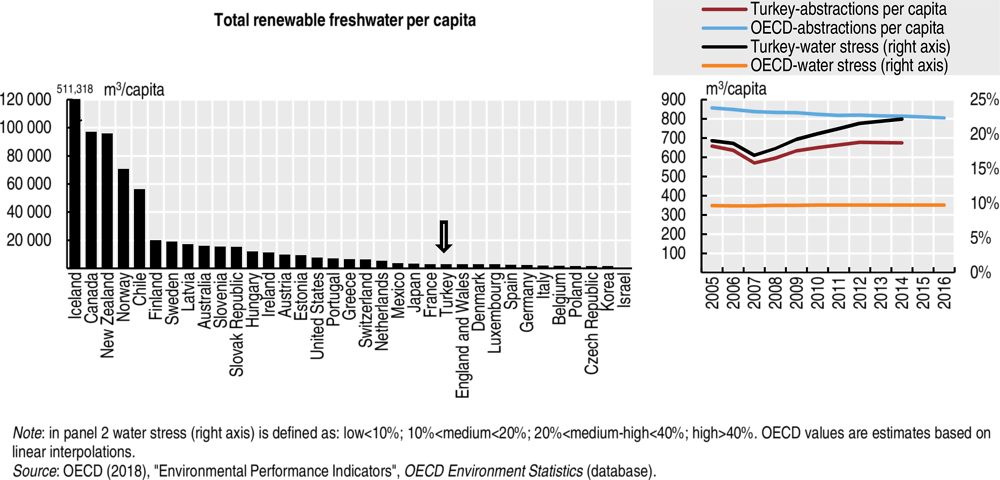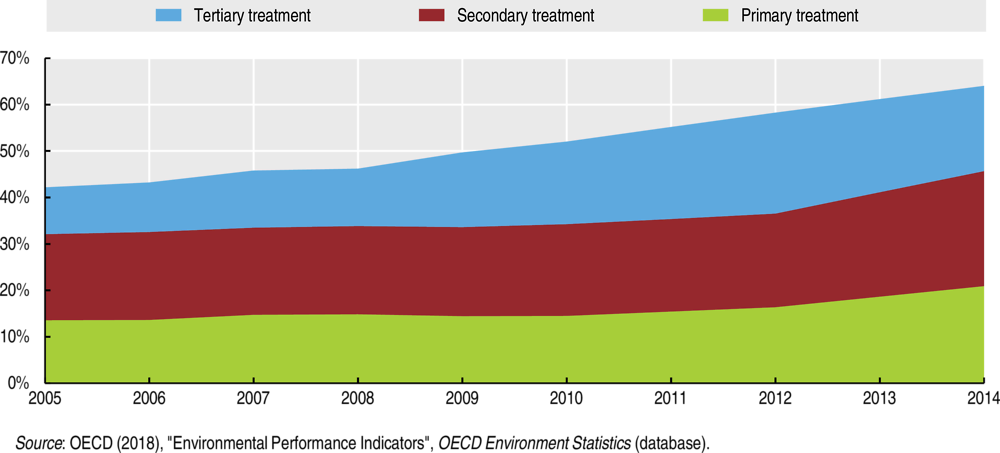Robust economic growth, coupled with rapid population growth, industrialisation and urbanisation have put considerable environmental pressure on Turkey. Some progress has been made in municipal waste generation and collection, and in forest cover, but important challenges remain in other areas, such as air pollution and energy consumption. This chapter provides a snapshot of key environmental trends in Turkey since 2005. It highlights the progress made in decoupling economic activity from environmental pressures and sketches out major policy developments.
OECD Environmental Performance Reviews: Turkey 2019

Chapter 1. Environmental performance: Trends and recent developments
Abstract
The statistical data for Israel are supplied by and under the responsibility of the relevant Israeli authorities. The use of such data by the OECD is without prejudice to the status of the Golan Heights, East Jerusalem and Israeli settlements in the West Bank under the terms of international law.
1.1. Introduction
As a rapidly growing economy, Turkey faces a range of environmental pressures, such as water scarcity and increasing air pollution and greenhouse gas (GHG) emissions, exacerbated by strong population and urbanisation growth.
In response to these pressures, and in an effort to comply with the European Union (EU) environmental acquis, Turkey has developed a number of strategies and adopted a range of laws in different environmental sectors, such as climate change, biodiversity and waste. The legislation is rapidly evolving. Since the opening, in 2009, of the environment chapter for EU accession, legislation has been largely aligned with key European standards. Turkey has been referring to sustainable development policies in its National Development Plans since 1992, following the Rio Summit. The 10th Development Plan (2014-18) has sustainability at its core, while the 11th plan, in preparation, is based on the Sustainable Development Goals (SDGs) (MoD, 2016). The Turkish Statistical Institute (TurkStat) is about to publish 80 SDG indicators. Turkey is also a party to many important international environmental conventions.
Since the last Environmental Performance Review (EPR) in 2008, Turkey has made progress in relatively decoupling its strong economic growth from a range of environmental pressures (air emissions, waste generation, energy and water consumption). However, despite these efforts and increasingly ambitious plans, environmental pressures remain strong. Furthermore, policy implementation is often hampered by lack of coherence, institutional clarity or the necessary financial and human resources. Ensuring the integration of environmental protection into economic plans remains a challenge.
1.2. Key economic and social developments
1.2.1. Economic performance
Turkey is the eighth largest OECD economy, but among the last in per capita terms, measured in USD 2010 purchasing power parity (PPP). It is, however, the fastest growing. The gross domestic product (GDP) per capita gap narrowed from 46% of the OECD average in 2005 to 63% in 2017. Despite adverse regional and domestic conditions, Turkey’s real GDP increased by 83% during 2005-17, compared to 21% for the OECD area. This represents 16 percentage points more than that of Ireland, the second fastest growing OECD economy (Figure 1.1).
The global financial and economic crisis of 2008-09 hit the country through weaker economic demand in export markets. Despite a good recovery, growth rates have slowed. Economic growth is projected to hover around 5% in 2018 and 2019 (OECD, 2018a).
Turkey still lags behind in terms of exported value added per capita. Its remarkable economic performance has not been sufficiently backed by gains in export market shares. While its economy incorporates an increasing share of foreign value added in its exports, its capacity to provide intermediate inputs to other countries’ exports is still limited. A recent OECD study reported that Turkey’s participation in global value chains remains below potential due to inefficient allocation of capital and labour. Such obstacles are inherent in bilateral trade agreements and entry regulations, underdeveloped human capital, and insufficient investment in innovation, research and development (R&D) and knowledge-based capital (Ziemann and Guérard, 2017).
Figure 1.1. GDP growth is the highest in the OECD area
According to the OECD Economic Surveys of Turkey, economic growth remains disproportionately driven by domestic demand and is largely fuelled by debt-creating capital inflows (OECD, 2018a, 2016a). The large external deficit makes the economy vulnerable to financial uncertainty, changes in global investors’ sentiment and political risks (EC, 2016; OECD, 2018a). Although the external deficit has declined thanks to falling oil prices and market share gains, especially in the European Union, it is still large. Domestic-led growth and low share of tradable goods and services create tension between strong growth and external sustainability (OECD, 2016a).
A stronger export sector would rebalance economic growth. Greater trade intensity would increase CO2 emissions due to transport and higher industrial output, but it would also help align Turkish environmental standards to international best practices. This is particularly important given its less stringent environmental policies compared to other OECD member countries (Ziemann and Guérard, 2017; OECD, 2018b) (Chapter 2).
Public spending pressures have been strong and government spending rose considerably, but the fiscal deficit has been kept in check (OECD, 2018a; 2016a). The government has a strong fiscal position, with a budget surplus of 1.3% of GDP, against a deficit of 2.8% in the OECD area (Basic Statistics). The gross financial debt, at 27.4% of GDP, is much lower than the OECD average (Basic Statistics). Monetary policy has been supportive, despite a series of tightening measures since 2017 in response to drifting inflation expectations following sharp currency depreciation (OECD, 2018a).
1.2.2. Structure of the economy and employment
As an emerging economy, Turkey has a much larger agricultural sector than other OECD member countries – 7% of total valued added compared to 1.7% for the OECD area. Consequently, the service sector has a lower economic share, 61% (Basic Statistics). By contrast, Turkey has a rapidly growing private industrial sector in basic industry, construction, transport and communication (IEA, 2016).
Despite this industrial dynamism, segments of the business sector, especially smaller businesses, operate on an informal basis. Institutional and regulatory settings for firms remain rigid despite recent reform efforts, notably in labour markets (OECD, 2018a).
Unemployment, especially among the young and women, is high, at 10.8% of the labour force, compared with 5.8% in the OECD area (Basic Statistics) (OECD, 2018a). At the same time, employment rates of the most vulnerable groups have increased, and rising labour force participation and job creation, mostly in service sectors, have strongly improved labour utilisation (OECD, 2017a).
1.2.3. Population, regional disparities and well-being
Turkey has a young and urbanising population. Population density is much higher than in the OECD area – 103 inhabitants/km2 compared with 35 (Basic Statistics), but is rather low in most of the country. The exceptions are the key cities of İzmir, Ankara and Istanbul, the latter being the largest city in Turkey and in Europe (IEA, 2016), and where almost 20% of the population live (OECD, 2016a).
Strong growth over the past decade has paved the way for convergence in living standards with higher-income OECD member countries. Sustained job creation outside agriculture, which accelerated in the 2010s, has improved well-being, notably in less-developed regions (OECD, 2018a). Life expectancy and expected years of schooling have improved. In addition, absolute poverty, measured as the share of people living below the national poverty line, declined sharply, from 28.8% to 13.3% over 2003-06. It settled at 1.6% in 2014 according to national sources (OECD, 2016a).
Nevertheless, this progress over the last two decades still falls short of OECD living standards. Turkey performs well in only a few dimensions of well-being relative to most other countries in the OECD Better Life Index. It ranks above average in civic engagement and governance (due to high voter turnout). Yet it ranks below average in income and wealth, health status, social connections, education and skills, jobs and earnings, subjective well-being, environmental quality (measured in terms of exposure to air pollution and water quality), work-life balance, housing and personal security (Figure 1.2).
Relative poverty, as measured by the share of the population earning less than 50% of the median disposable income, is higher than in the OECD area – 17.8% compared with 11.3%. Income inequality, as measured by the Gini coefficient, remains high, 0.4 compared with 0.32 in the OECD. Average household disposable income per capita was still 54% of the OECD average in 2014 (at current PPP). Educational achievements are modest, with 39% of Turkish adults aged 25-64 having completed upper secondary education (OECD, 2017a; 2016a), and 20% having attained tertiary education, against an OECD average of 36.9% (Basic Statistics).
Figure 1.2. Well-being indicators are below OECD averages
Economic and social progress are not evenly distributed; regional disparities are large. Average household income in Istanbul is almost three times higher than in south-eastern Anatolia, the highest regional gap among OECD member countries. Furthermore, while less than 5% of people in Istanbul live with less than half of the national median income, this share is 50% in some areas of south-eastern Anatolia (OECD, 2016a). Regional disparities in terms of GDP per capita were the fifth highest in the OECD, as measured by the Gini index across small regions. Turkey has the widest regional variations in the OECD in terms of economic structures (e.g. share in industry). Regional disparities show also in youth unemployment rates, employment gender equality and functional literacy rates between rich and poor youth (OECD, 2016b; Spaull, 2017).
1.3. Transition to an energy-efficient and low-carbon economy
Strong economic and population growth has come at the price of increasing energy consumption, GHG emissions and air pollution. Despite having indigenous coal and renewable energy resources, Turkey is highly dependent on imported energy, notably oil and natural gas. As the pace of resource development fell further behind demand growth, energy self-sufficiency (production divided by total primary energy supply – TPES) declined from 28% to 25% between 2005 and 2017 (IEA, 2018).
Turkey plans to reduce import dependency and ensure energy security by diversifying imports, integrating regional markets (notably the European electricity market), increasing domestic production (notably coal and renewables, but also nuclear), fostering energy efficiency, preventing waste in all processes and reducing consumption through awareness campaigns. These measures have not yet paid off, and numerous challenges remain on the path towards a more energy-efficient and low-carbon economy.
1.3.1. Energy structure, intensity and use
Turkey’s energy demand growth is among the highest in the OECD. TPES increased by 76% over 2005-17, compared with a decrease of 4% for the OECD area (IEA, 2018). Population has grown by 1.5% annually since 2005 and is projected to grow by another 3.8% by 2020. Consequently, projections by the Ministry of Energy and Natural Resources (MENR) show that this energy trend will continue for the medium and long term (MEU, 2016a).
Turkey is endowed with large reserves of lignite and some hard coal, but has few oil and gas resources (IEA, 2016). About half of domestic energy production in 2017 came from fossil fuels, of which 43% of coal, 7% of oil and 1% of natural gas, and the rest from renewables (IEA, 2018). The energy mix is very carbon-intensive, with a predominance of fossil fuels, and the share of renewables is still below potential. Given the trend and the government policy to increase use of domestic coal, the energy sector is likely to remain carbon-intensive (Chapter 4).
Energy mix
Fossil fuels represent 88% of TPES, with the remainder supplied by renewables (mostly hydro and geothermal). Renewables posted a high growth during 2005-17, but less than coal and natural gas. Their share in total TPES is higher than the OECD average (Basic Statistics), but it has remained stable at 12%. Energy supply from fossil fuels increased by 75% during the same period (Figure 1.3). While the share of coal has remained stable, the part of natural gas has increased at the expense of oil.
Natural gas is increasingly used in the residential, power and industry sectors, and imports have increased as a result. Still, the residential heating and industry sectors consume a large share of coal, which is uncommon by international comparison (most coal is normally used in power generation) (IEA, 2016). Oil is mostly used in the transport sector.
Electricity consumption has also increased considerably, by 91% over 2005-17. Around 70% of electricity is produced from coal and natural gas, and the rest from renewables. Electricity supply from coal and renewables has more than doubled since 2005, while the use of oil has decreased (Figure 1.3).
The government expects demand for primary energy to reach 218 million tonnes of oil equivalent (toe) in 2023 (more than the double of 2016 total consumption). The share of coal is predicted to increase, while the part of natural gas is expected to decrease (to reduce imports) and that of oil to remain stable (MEU, 2016a). To meet this growing demand and reduce import dependency, the government plans to increase domestic production, especially of coal and renewables. Turkey still imports most of the coal used in power generation, given the international hard coal price decrease and the low quality and calorific value of local lignite. However, there could be tension between the objectives of reducing import dependency (by relying on domestic coal) and curbing air emissions (by replacing coal with imported natural gas in heating systems).
Figure 1.3. Energy supply is heavily dependent on fossil fuels
The MENR Strategic Plan for 2015-19 sets a target of increasing the amount of electricity generated from domestic coal to 60 TWh/year by 2019, that is, almost doubling the production in less than five years. Given the plants announced, proposed and under construction, Turkey has one of the largest coal plant developments in the world (auctions for coal mines will be launched in 2018-23), outside the People’s Republic of China and India. Turkey is also progressing with its plans to deploy three nuclear power plants in the next decade, and has accelerated the deployment of renewable energy. Nuclear power is absent from Turkey’s energy mix, but it is one of the strategic objectives of the MENR. Turkey already ratified agreements with the Russian Federation and Japan to construct two nuclear power plants, which are expected to add 9.2 GW of baseload capacity. A third plant is planned for after 2023. These nuclear power plants, once operational, are expected to meet 10% of electricity consumption.
Energy intensity
Expected steep future growth of energy consumption is reflected in the relatively low energy consumption per capita. TPES per capita is still low compared to other OECD member countries – 1.8 toe/capita in 2017 compared to 4.1 for the OECD area. It is, however, growing fast, 47.9% over 2005‑17 compared to a decrease of 11.3% in the OECD area (IEA, 2018).
Energy intensity (TPES divided by GDP) is around the OECD average. Turkey’s target to reduce energy intensity by 20% by 2023 (from 2011) requires additional efforts to be reached (IEA, 2016) (Chapter 4). TPES intensity has decreased to 96% of the 2005 value, whereas total final consumption intensity has decreased more (88%). By contrast, electricity consumption intensity has remained relatively stable. The decrease in energy intensity is, however, not steady. It remains dependent on external economic conditions, as the effects of the 2008‑09 global financial crisis show (Figure 1.4).
Figure 1.4. Energy intensity is decreasing, but not at a steady pace
There is no comprehensive assessment of the actual energy savings achieved from the numerous measures presented by the government. An evaluation of the gap between targets and the actions taken is missing, and the government has not developed methodologies and indicators to measure progress (IEA, 2016). Judging by the trends in energy supply and consumption (relative decoupling of TPES and GDP since 2005) and in emissions (see below), these measures do not seem to have had a significant impact so far (Figure 1.4).
Renewable energy supply
Turkey has important wind, water, geothermal and solar resources to explore the potential of renewable energy (World Bank, 2012). The country has been diversifying its energy mix by increasing investment in these sources. In one decade, installed renewable energy capacity has almost doubled (IEA, 2016). Turkey figures among the top world performers in installed capacity in 2017, especially in solar, wind, geothermal and hydro-power (REN21, 2018). The tenth Development Plan had a target of increasing the share of renewables in electricity production from 25.3% in 2006 to 29% in 2018. In addition, the Electricity Energy Market and Supply Security Strategy had a target of 30% by 2023 (EC, 2016). This target has almost been reached, at 29.3% in 2017.
The sector is, however, still in its development phase and the share of renewables is fluctuating, depending on hydropower production and the use of coal and gas. Over two-thirds of renewable energy comes from geothermal and hydro sources, followed by solid biofuels. Recent competitive auctions for large-scale solar and wind electricity projects (1 GW each) have been successful in driving investment. Other off-shore wind and on-shore wind and solar projects have been planned. The installed capacity is expected to further increase. Yet wind and solar still command a low share of TPES, and tidal energy is not utilised (Figure 1.5).
Figure 1.5. Renewables’ share in TPES has remained relatively stable
Notwithstanding the increase in installed capacity, the share of renewables in TPES has remained fairly stable. This is because conventional energy sources and imports met most of the increase in energy demand (IEA, 2016), and renewables do not play a major role in the growth of transport and heating sectors. Renewables are still exploited below potential. For example, around 1 150 MW of geothermal power are installed, with a target of 1 500 MW by 2018. However, only a part of the country’s geothermal potential, probably less than half, has been put to use. A similar picture holds for solar power (Chapter 4).
The government expects to further increase the use of renewables, especially hydro and geothermal, and envisages exploiting the maximum potential (MEU, 2016a). However, the government’s plans are unclear. While it has technology-specific targets in different strategies and plans for 2023, as well as the 2030 Agenda for Sustainable Development, some are inconsistent. For example, the indicative target in Turkey’s Intended Nationally Determined Contribution for increasing wind capacity is less ambitious than the one presented in the National Renewable Energy Action Plan (Chapter 4). Furthermore, despite the interest of private investors, the electricity network is not adequate to satisfy the demand for renewable energy (IEA, 2016). There are also some concerns that fees stemming from tenders and other investment requirements are delaying or stalling installation of some licensed solar projects (Chapter 3).
Energy consumption
Total final energy consumption (TFC) has increased by 50% over 2005-16, compared to a decrease of 2.3% for the OECD area. Industry (notably non-metallic minerals) and transport are the largest consumers (27% each in 2016), followed by the residential sector. Transport is the sector that, after the commercial and public services sector, has shown the highest consumption growth over 2005-16 (IEA, 2018) (Figure 1.6).
Figure 1.6. Industry and transport are the largest energy consumers
The government adopted a National Energy Efficiency Action Plan in 2017. However, this plan has no sectoral targets and does not spell out actions to be taken. Developed with the help of the European Bank for Reconstruction and Development (EBRD) and funded by the European Union, it targets a 14% reduction of primary energy consumption by 2023 from business-as-usual, for a cumulative savings of around 23.9 Mtoe (Chapter 4). Another objective is to reduce energy intensity by at least 20% below 2011 levels by 2023, mainly through improved efficiency. The MENR Strategic Plan 2015‑19 does not contain any new energy efficiency target (IEA, 2016).
Energy efficiency is regarded as one of the most important components of national strategies (Chapter 4), but several measures need to be strengthened to reach the stated objectives. For example, the building sector – one of the most energy consuming in many countries – could make a larger contribution to energy efficiency. The tenth Development Plan sets the target of reducing energy consumption of public buildings only by 10% by 2018 compared to 2002. The main measures in the residential sector are compulsory “energy consumption class” labels and promotion of renewable energy for buildings larger than 20 000 m2; a central heating system for those larger than 2 000 m2; and tax breaks for real estate income for energy saving expenses. New buildings must have at least a “C‑class” certificate. Thermal insulations and solar-powered energy systems for private buildings are not subject to a construction permit if the energy performance certificate has at least a C‑class rating. Energy performance certificates are expected to become compulsory for all buildings by 2020 (Chapter 4).
However, only about 8% of buildings have such certificates. There are no quantitative targets and timeframes for reducing energy consumption in private buildings. There are low-interest loans for renovation works to obtain A‑ and B‑class energy certificates, but no incentives for insulation works. Financing of building and renovation works mainly comes from international sources. For example, the Turkish Residential Energy Efficiency Financing Facility developed by the EBRD provides loans to owners who wish to invest in energy efficiency projects.
1.3.2. Transport
Transport is a major source of energy consumption and air pollution, especially in densely populated cities. This is due to the dominance of road transport and an ageing vehicle fleet. Although the road vehicle stock per capita is still low compared to other OECD member countries, it is growing fast – by 72% over 2005‑16 (OECD, 2018c).
Istanbul has recently made efforts to enhance the public transport system. While tram routes in metropolitan municipalities and train routes within and between cities are expanding, these efforts still fall short of expectations. The railway network grew faster than the road network in 2005-16 (by 14.5% and 12.8%, respectively), but roads largely dominate the transport system. Railway is hardly used for freight (3.7%) or passenger transportation (1.4% in 2016) (ITF, 2018).
The average age of registered cars was 13.2 years in 2017 (TurkStat, 2018a). The share of diesel cars has strongly increased over the past decade, from 6.8% to around 37% between 2005 and 2018 (Chapter 3). The share of diesel in final energy consumption by road transport increased from 56% in 2005 to 69% in 2015, compared with 34% and 37%, respectively, for the OECD area (ITF, 2018).
The government is implementing a scrapping programme for old vehicles. However, over 2005‑17, fewer than 1% of vehicles were withdrawn annually from traffic in return for a payment (TurkStat, 2018a). There are targets to reduce the share of domestic passenger transport on highways to 72% of the current level by 2023. At the same time, Turkey wants to increase the share of rail in freight to 15% in 2023 and 20% in 2035 and in passenger transportation to 10% in 2023 and 15% in 2035. Although rail infrastructure investment, given its low starting base, grew faster than road over 2005-16, most investments are concentrated on road transport. The share of infrastructure investment in 2016 was 15% for rail, 65% for road and 20% for airports (ITF, 2018). Roads are expected to account for one-quarter of future infrastructure investment, compared to railways at 9% (Chapter 3). Seaway freight and passenger transportation is also slated to increase by 2023 (MEU, 2016a). Air passenger traffic is projected to almost double, from about 193 million passengers in 2017 to 350 million in 2023.
A Transport Master Plan outlining investment priorities for inter-regional and international transport has been prepared, but the implementation schedule is, as of November 2018, uncertain. Turkey is also amending the 2008 transport legislation to establish low emission zones, which would be managed at the local level. The government plans to stimulate domestic demand through investments in charging infrastructure and incentives for widespread clean vehicle use (Chapter 3). Motor vehicles produced after 1 January 2018 are subject to the latest emission limits of the EU Framework Directive for the approval of motor vehicles. Fuel distribution companies and refineries are obliged to blend 3% of domestically produced bioethanol to gasoline and 0.5% of domestically produced biodiesel to diesel.
The 2008 OECD EPR of Turkey recommended to strengthen efforts to integrate air quality concerns into transport policy. Specifically, Turkey should shift from road to public transport (e.g. railways), with appropriate cost-benefit analysis of investments and co‑operation among levels of government and relevant sectors, and extend the use of cleaner motor vehicles (OECD, 2008). This recommendation is still valid.
1.3.3. Greenhouse gas emissions
Emissions profile
Growing energy consumption and transportation have caused important GHG emission increases. Given the economic and population growth, the government expects emissions to increase further. Turkey is the OECD country with the highest GHG emission growth, 49% over 2005-16. GHG emissions have followed closely GDP growth and have been relatively decoupled only in recent years. Emissions per capita, although among the lowest in the OECD, have increased by 60% since 1990 (Figure 1.7).
Figure 1.7. GHG emissions have started to relatively decouple in recent years
Most and fastest growing GHG emissions come from power production and transport, followed by industrial production. Only the waste sector witnessed a small decline (Figure 1.8). As in most OECD member countries, CO2 is the main contributor to GHG emissions, amounting to 81% of the total in 2016. This is followed by methane (11%), nitrous oxide (6%) and hydrofluorocarbons (1%) (OECD, 2018d). Although the Turkish economy is still less CO2-intensive than the OECD average, it is not making much progress. Production-based CO2 intensity (CO2 over GDP) declined from 0.2 kg/USD 2010 in 2005 to 0.18 in 2015, compared to a decrease of 0.31 to 0.24 for the OECD area over the same period (OECD, 2018e).
A National Climate Change Strategy was adopted in 2010, followed by the National Climate Change Action Plan in 2011. Their adoption was a positive step to lay the ground for action, with short- and long-term qualitative objectives and a set of actions for mitigating GHG emissions and for adapting to climate change. While some actions have been taken, adequate monitoring and evaluation of the plan has largely been missing (Chapter 4).
Although Turkey has not yet ratified the Paris Agreement, it announced that it would reduce GHG emissions by up to 21% from the “business-as-usual” level by 2030. This entails more than doubling emissions between 2015 and 2030 (OECD, 2016a, Chapter 4). The government expects part of GHG emission mitigation to come from significant development of renewable energy, especially in the power sector, by increasing solar and wind generating capacity and utilising the large geothermal potential (Chapter 4).
Figure 1.8. Energy industries and transport are the largest GHG contributors
Limiting emission growth of GHGs and other air pollutants from coal-fired power plants and industrial installations, as well as from road transportation, is among the goals of the National Climate Change Action Plan. However, given the planned increase of domestic coal-fired electricity generation, ubiquitous use of coal, and unsteady growth of renewables, achieving this goal will be challenging.
1.3.4. Air emissions and air quality
Air quality is a major concern, especially in large cities and industrialised regions. Population exposure to fine particulate matter is higher than the EU and OECD averages, and the World Health Organization’s guidelines (OECD, 2018c).
Unlike in other OECD member countries, mortality and welfare costs of premature deaths from exposure to outdoor PM2.5 and ozone have increased since 2005. Disability-adjusted life years (number of years lost due to exposure to air pollution) have slightly declined, but remain above the OECD average (Figure 1.9).
Coal-based heating systems, especially the use of low-quality fuel and burning systems (MEU, 2016a), and industrial and mobile sources are the main factors of PM2.5 emissions growth. In a recent EU review, Turkey was ranked highest, at 29%, among 19 regions and countries with respect to the share of industry in PM2.5 sources (EU, 2015). The regional distribution of PM2.5 exposure analysed by the OECD (Mackie, Haščič and Cárdenas Rodríguez, 2016) shows that industrial regions display particularly high pollution levels, with no tangible improvement over the last two decades (OECD, 2016a). Recorded air pollution is highest in Eastern Turkey (IEA, 2016) and in provinces where coal plants are concentrated, such as Çanakkale, İzmir and Tekirdağ.
Figure 1.9. Rising mortality and welfare costs of air pollution
Emissions profile
Emissions of major air pollutants have broadly followed the growth in GDP. They decreased when the effects of the global economic crisis kicked in, then grew again in 2014-15 (Figure 1.10).
Figure 1.10. Relative decoupling of air emissions from economic growth in recent years
The bulk of SOx emissions is produced by power generation (60%), followed far behind by industrial combustion (23%). More than half of NOx emissions come from road transport (16%) and power stations (43%). Industrial processes and product use, especially cement factories, are primarily responsible for PM10 emissions (68%). Industrial and other combustion represents 85% of carbon monoxide emissions, while industrial production and agriculture are responsible for more than two-thirds of non-methane volatile organic compounds (NMVOCs).
The trends are mixed across sectors. Road transport emissions declined for all pollutants except SOx. Power stations witnessed a decrease in PM10 (-11%) and carbon monoxide (‑62%), but saw an increase in all other pollutants. Industrial combustion PM10 and carbon monoxide emissions have decreased, but all other pollutants’ emissions have increased. Industrial production and product use posted a decrease only for carbon monoxide. Waste is the sector showing a more consistent emissions decline during 2005‑16, except for NMVOCs.
Main policies and measures
The Regulation on Air Quality Assessment and Management (BAQAM) is being revised to harmonise it with the EU Clean Air for Europe Directive (2008/50/EC). BAQAM is partially aligned with the EU acquis, and the timeframe for full transposition remains uncertain. Other regulations govern emissions from residential heating, exhaust gas emissions of motor vehicles and industry. Ambient air quality standards were revised in 2009 and will gradually become more stringent. Most of these standards are expected to align with the EU ones by 2019, while those for NO2 in 2024. There is no established date for the alignment of standards for ozone and heavy metals.
BAQAM is mainly implemented through Clean Air Action Plans (CAAPs) at the provincial level. The work is co‑ordinated by provincial directorates of the Ministry of Environment and Urbanization (MEU). Provinces and cities are categorised as having a high or low “pollution potential”. Based on the 2012‑13 air quality assessment, 64 of 81 provinces had high pollution potential. CAAPs have been prepared and enacted in these provinces, while for the remaining 17 provinces the plans are voluntary. The main measures in the CAAPs relate to industry, residential heating and road transport. They stipulate bicycle lanes, city railway networks, filters for industrial processes, closed systems for coal storage, central heating for specific industrial sites (e.g. shoe manufacturing), building insulation, smart traffic control systems, etc. When limit values are exceeded, local environmental boards may enforce some measures, such as alternate vehicle circulation and restrictions on residential heating.
Several institutions at the provincial level are involved in the preparation and implementation of CAAPs, but the main responsibilities lie with municipalities. Implementation of the CAAPs is slow, however, due to various factors. These include high municipal staff turnover, frequent amendments to the legislation regulating roles and responsibilities, and limited technical and human resource capacity at the provincial and municipal levels, especially in less-developed regions.
Industrial emissions are governed by the 2014 regulation on Industrial Air Pollution Control. It includes 27 groups of industries, with different emission limits, which are only partially harmonised with the EU standards. The MEU and Dokuz Eylül University are conducting a project over 2017-20 to determine the emission limits for industrial air pollution to further align legislation with EU standards.
Given their weight in air emissions, road transport and power stations are key areas for policy intervention. In the transport sector, the government needs to stimulate a modal shift from road to public transportation, use integrated urban planning and promote alternative fuels and renewal of the truck fleet. The government is preparing amendments to legislation that would introduce low-emission zones (congestion pricing and restrictions on heavy duty vehicles) (Chapter 3). In the power sector, the use of coal should rely on efficient and clean coal technology. This would mean refurbishing or closing old plants. Turkey has transposed the EU Large Combustion Plant Directive and invested in clean coal research and development, but existing coal plants have not yet been refurbished (IEA, 2016). The envisaged gradual substitution of coal with natural gas in residential heating would reduce local air pollution. However, better exploiting the geothermal potential for heating would be more sustainable and would reduce import dependency.
1.4. Transition to a resource-efficient economy
The tenth Development Plan aims at more sustainable consumption by raising awareness about avoiding and minimising waste, recycling and more sustainable resource use. Several policy documents highlight the need to change consumer behaviour. To achieve the double objective of reducing import dependency and making consumption sustainable, the government aims at more effective use of the domestic natural resource potential. This is to be achieved by harnessing the economic benefits of recyclable waste; supporting efforts to increase use of domestic scrap; and initiatives for scrap collection, separation and processing centres. One of the National Eco-Efficiency/Cleaner Production Programme’s (2014‑18) objectives is to increase resource efficiency by reducing resource use throughout the life cycle of a product, preventing waste at the source and encouraging use of new production technologies (EEA, 2015a).
In waste management, legislation is largely aligned with the EU acquis. The government plans to move away from a disposal-centred approach and emphasises circular economy and zero waste. Material consumption per capita is lower than the OECD average. However, it has not decoupled from economic growth, and the great majority of municipal waste is still sent to landfills.
1.4.1. Material consumption
Turkey is endowed with some natural resources, such as antimony, coal, chromium, mercury, copper, borate, sulphur and iron ore. However, it is not self-sufficient in terms of energy raw materials (Section 3) and its iron ores are low-grade, which causes import dependency. The increase in imports of intermediate goods is the main concern that drove the Programme for Reducing Import Dependency (EEA, 2015a).
Turkey is well below the OECD average in terms of material productivity, and the consumption of materials has not decoupled from economic growth. Domestic material consumption (DMC) grew faster than GDP during 2005‑11, particularly during the 2008 economic crisis, when the physical trade balance (import minus exports) deteriorated rapidly. As a consequence, material productivity (GDP over DMC) has been decreasing since 2005. It has only picked up in recent years thanks to high economic growth (Figure 1.11).
Figure 1.11. Material consumption has not decoupled from economic growth
As in many other OECD member countries, construction constitutes the bulk of materials used. Fossil energy materials/carriers, especially coal, lignite, oil and natural gas, represent an important share, but grew less than ores and minerals over 2005‑15. Metal ores are the material category showing the highest growth, mainly due to non-ferrous and precious metals, which are mostly domestically produced.
Turkey does not have a dedicated material resource policy. The tenth Development Plan emphasises waste management and circular economy, especially the use of waste as fuel and recycled materials. It envisages increasing domestic extraction and materials reuse to reduce import dependency, assigning priority to iron ore, marble and boron. The Input Supply Strategy and Action Plan (2013‑15) prioritised iron/steel, non-iron metals and raw materials, as well as intermediate goods for the plastic, petroleum chemicals and pharmaceuticals sectors (EEA, 2015a). The MENR’s Strategic Plan (2015‑19) aims to increase exploration by facilitating the permitting process, as well as to obtain valuable minerals from import and domestic concentrates, and by recycling from secondary (waste) products (MENR, 2014).
1.4.2. Waste management
Waste management is key to reducing import dependency by promoting a more circular economy and mitigating climate change. Although emphasised in development plans, waste management has not been a policy priority historically. Duties and powers have been distributed among many institutions, with inadequate co‑ordination and co‑operation. Furthermore, the waste fees and taxes collected are inadequate (there is no landfill tax) (Bakas and Milios, 2013).
In 2015, the MEU adopted a new regulation, replacing previous ones and providing a single comprehensive waste management framework. This regulation has transposed the EU Waste Framework Directive (2008/98/EC), introducing the concepts of waste reuse and extended producer responsibility. Policy documents have also emphasised recycling, reuse, recovery of waste and special waste streams (oils, tyres, accumulators and packaging).
Some progress has been made in expanding waste treatment infrastructure, including sorting, recycling and medical waste treatment. However, further work is needed to increase separate collection of different types of waste, reduce the amount of biodegradables going into landfills and better manage hazardous waste. Local waste management plans have been put in place in some municipalities, while in others they are expected to be introduced by 2023. Economic instruments to promote recycling and prevention of waste generation remain limited (EC, 2016).
Municipal waste
At 425 kg/capita/year in 2016, generation of municipal waste in Turkey is below the OECD average of 523 (Basic Statistics). It has also been decreasing faster over 2005‑16 – by 8% compared to a 5% decrease for the OECD. Generation of municipal waste has therefore decoupled from economic growth (Figure 1.12). The share of the population served by municipal waste services increased from 81% to 93% over 2006‑16 (TurkStat, 2018b). During the same period, the share of waste collected in total municipal waste generated increased from 84% to 94%.
However, despite this progress, waste management does not live up to the ambitious goal of a circular economy. About 90% of municipal waste is sent to landfills (one of the main sources of methane emissions). The rest is burned in open areas, buried or discarded in the environment. Only a small quantity is sent to composting plants or other recovery facilities (Figure 1.12).
Turkish authorities are seeking solutions to reduce the amount of municipal solid waste, especially biodegradable waste, going to landfills, and to increase recycling of materials (Box 1.1 ). The Climate Change Action Plan 2011-23 set the objectives to:
reduce the quantity of biodegradable waste sent to landfills to 75% of the 2005 quantity by 2015, 50% by 2018 and 35% by 2025
dispose all municipal waste in integrated disposal facilities by 2023
put an end to all uncontrolled waste disposal by 2023.
The 2017 regulation on Packaging Waste Control, aligned with the EU Directive 94/62/EC on packaging and packaging waste, sets annual recovery targets for glass, plastic, metal, paper/cardboard and wood. The National Waste Management and Action Plan for 2023 sets the objectives to:
recycle 35% of generated waste (estimated at 13%), mainly through the extended producer responsibility
reduce the share going to landfills to 65%
increase waste collected separately at the source from 5.3% in 2014 to 12% in 2023
increase the recycling ratio of municipal waste over 2014-23 by biological treatment from 0.2% to 4%, by mechanical-biological treatment from 5.4% to 13%, and by thermal treatment from 0.3% to 8%.
Box 1.1. Zero-waste project in public buildings
In the context of the “zero-waste” initiative, under the patronage of the First Lady, the MEU has recently implemented a zero-waste project in the ministry’s premises. Waste is collected separately, and food leftovers are sent to animal shelters. Compost units have been installed to produce manure. Thanks to this initiative, waste from the ministry’s premises is no longer sent to landfills.
Awareness campaigns are organised across the country and the government aims to expand this project to all ministries in 2018 and to all public institutions and public spaces by 2023.
Source: Country submission
In 2016, 9.2% of municipal waste was collected separately and sent to licensed recovery facilities, as well as to biogas facilities (TurkStat, 2018b). Infrastructure for waste disposal and recovery has increased from 28 licensed facilities to 521 for collection and separation, and 676 for recycling over 2003‑15. Progress was also made in collecting recyclables, such as electrical and electronic equipment (55 000 tonnes in 2017) and tyres (54% recycling). Around 2.5 million tonnes of packaging waste are collected annually and the recovery rate for recyclables (glass, paper, plastic and metal) is around 60%. Charges may be applied to plastic bags as of 2019; 7 composting facilities and 20 facilities for electricity production from methane gas are in operation. On the other hand, separate waste collection at the household level is not widespread. Therefore, extended producer responsibility mainly covers waste from industrial and commercial premises.
Figure 1.12. Municipal waste generation has decoupled from GDP growth, but most waste is landfilled
Low investments at the local level remain a challenge. The recent administrative reform, which has created new municipalities and metropolitan areas, allows for economies of scale. However, smaller areas face operational and implementation challenges. For these areas, the government counts on participation of the private sector (i.e. private-run waste collection services), which is not yet actively engaged.
Hazardous waste
Generation of hazardous waste per capita is still much lower than the EU average, 70 kg/capita compared to an estimated 197 kg/capita for the EU‑28 in 2016 (Eurostat 2018b). It is, however, growing fast: almost fivefold over 2004-16. The bulk is chemical and combustion waste, mainly from the mining and quarrying sector (Eurostat, 2018a). According to TurkStat data, about 7% of the waste generated in 2016 by the manufacturing industry was hazardous, of which 71% was sent to licensed waste treatment facilities (TurkStat, 2018a). Hazardous waste producers are registered and obliged to report to authorities. In addition, Turkey is testing a global positioning system to track hazardous waste movement. The number of hazardous waste recovery facilities increased from 185 in 2010 to 468 in 2017. These include 46 energy recovery facilities such as incineration plants and cement factories (MEU, 2016b). However, Turkey has been slow in improving hazardous waste treatment, and relevant legislation has not yet been fully implemented.
Chemicals management
Over the past years, Turkey has made efforts to strengthen its legal framework in the area of chemical safety. The new regulation on chemicals registration, evaluation, authorisation and restriction came into effect in December 2017, replacing three existing laws. The MEU has been appointed as the competent authority. Turkey is therefore in a good position to improve the protection of human health and the environment from the potential risks posed by chemicals. However, thorough implementation of the law will be critical. This will largely depend on both technical and financial resources.
A pollutant release and transfer register (PRTR) is an essential component of chemical management systems, as recommended by the 2018 OECD legal instrument on PRTR. It provides and tracks publicly accessible data on chemicals or pollutants released to air, water and soil and transferred off-site for treatment. The establishment of a PRTR largely depends on a legal framework that allows the necessary infrastructure and administrative capacity to maintain it. This legal framework is still lacking in Turkey, and its absence undermines numerous environmental safety policies. To address this issue, Turkey drafted a PRTR regulation. Once adopted, the regulation should allow the transposition and implementation of the European Pollutant Release and Transfer Register (E-PRTR). In addition, in 2017, Turkey launched a two-year project to build technical capacity for implementation of PRTRs.
The Rotterdam Convention on international trade of hazardous chemicals was ratified in 2017, and draft regulations have been prepared to align legislation with EU requirements for export and import of hazardous chemicals and on persistent organic pollutants. Turkey has made progress in harmonising its legislation with the EU Seveso II Directive. In 2013, it adopted a regulation on the prevention and mitigation of major industrial accidents. Despite the legislative and institutional efforts, many accidents have occurred in the past ten years (180 incidents were identified in 2017), including several major ones (KMO, 2017).
Turkey is vulnerable to natural and human-made disasters. Indeed, the level of exposure to human-made hazards is growing at a faster pace than the country’s capacity to manage risks. The 2008 OECD EPR recommended increasing communication between local authorities and the central Disaster and Emergency Management Authority, as well as granting open-access to information related to chemical accidents. Despite the mounting risk to human-made hazards, Turkey has not yet implemented this recommendation.
1.4.3. Agriculture
Agriculture is both a key economic sector and an important source of pollution and water use. It represents 7% of the economy, accounts for more than 11% of total exports and employs more than 20% of the workforce (Basic Statistics; OECD, 2017b). The sector is a large user of land and energy, as well as a large emitter.
The intensity of input use per hectare of agricultural land is, in general, lower than in many other OECD member countries. However, phosphorus balance is particularly high in Turkey due to intensive livestock production (OECD, 2017b). Livestock density (head of sheep equivalent/km2 of agricultural land) was 387 in 2016, compared to 232 for the OECD area. It grew by 38% over 2005-16, much faster than the OECD average increase of 8%. Consumption of nitrogen fertilisers at almost 5 tonnes/km2 of agricultural land is above the OECD average of 2.7. Pesticide use (tonnes/km2 of agricultural land) is not among the highest in the OECD, but is growing fast, showing a 28.6% increase over 2005-16 (OECD, 2018c).
Agriculture is also the sector that uses most of abstracted freshwater, almost 90%. The expansion of irrigated areas, combined with the expected decrease in precipitation due to climate change, may have contributed to increased water stress. Turkey introduced the Action Plan for the Program on Enhancing Efficiency of Water Use in Agriculture in 2015. The plan prioritises modernising irrigation infrastructure; extending water-saving practices through training and extension programmes; revising support policies based on water scarcity; and improving water governance. It aims to decrease use of underground water and increase use of water-saving irrigation technologies (OECD, 2017b). However, most agricultural water pricing is not yet tied to the volume of water used (Chapter 3).
The area under organic agriculture has grown from 0.5% of total agricultural land in 2005 to 1.4% in 2016 (FAO, 2018). The government aims to increase this share to 3% by 2023 (MEU, 2016a). The Ministry of Agriculture and Forestry (MAF) is developing a certification system for organic agriculture, support-related research, and development, demonstration and awareness campaigns. Concessional loans for organic agriculture have been provided since 2009, but represent a small share of total support to agriculture (Chapter 3).
The objective of environmental sustainability has been progressively integrated into agricultural policy. MAF, for example, implements an Environmentally Based Agricultural Land Protection Scheme. It started with external financial support in 2006 and, since 2009, has continued with national resources. The scheme will be extended to 57 provinces in 2018. Support payments, based on land area, are made annually for three years for agricultural practices with minimum soil tillage (to conserve soil and water structure and prevent erosion) and environmentally friendly agricultural techniques (water and fertiliser savings, and organic agriculture). Turkey has also made progress by eliminating subsidies for agricultural water use. However, environmental sustainability and rural diversification measures attract a relatively small share of government spending (OECD, 2016c) and subsidies for good practices represent a small share of total support (Chapter 3).
1.5. Managing the natural asset base
Turkey’s geographical position and geomorphological configuration make it a hotspot of biodiversity, but also a water-scarce and erosion-prone country. Over 60% of the country territory faces severe or very severe water erosion problems (MEU, 2016b). Efficient use of land and water resources is considered a priority in the tenth Development Plan. The EU Integrated Environmental Approximation Strategy (2007‑23) emphasises rational and sustainable use of natural resources, particularly efficient use of water and energy in households and industry (EEA, 2015a).
Unlike many other OECD member countries, Turkey expanded natural and semi-natural areas – a 2% net increase over 1992-2015 – mainly thanks to afforestation and reforestation. On the other hand, rapid urbanisation has led to urban sprawl, mainly around major cities. Built-up area increased by 57% over the same period, compared to 32% for the OECD area (OECD, 2018f).
1.5.1. Biodiversity
Turkey has exceptionally rich biodiversity, both in flora and fauna species, 31% of which are endemic. About three-quarters of European flora and fauna species can be found here (OECD, 2016b). There are different micro-climatic zones and biogeographic regions, each with its own natural ecosystems. Because Turkey is located at the intersection of the Mediterranean and Near Eastern gene centres, it is genetically very diverse. There are five micro-gene centres, offering important genetic resources for the future sustainability of many plant species cultivated across the world. Many domestic animal races were originally bred in Anatolia and spread to other regions of the world (EEA, 2015b). Furthermore, Turkey is located on two major bird migration routes, making it an important place for feeding and breeding (MEU, 2016a).
The government signed the United Nations Convention on Biological Diversity in 1992 and ratified it in 1996. To meet obligations under the Convention, the National Biological Diversity Strategy and Action Plan (NBDSAP) was prepared in 2001 and updated in 2007. A new biodiversity plan for 2018-28 is under preparation. However, framework legislation on nature protection has not yet been adopted (EC, 2016).
Turkey has made progress in biodiversity conservation, increasing protected and forest area. However, it has not submitted national targets under the Convention on Biological Diversity. Habitat loss and fragmentation continue as a result of urban, transport and industrial expansion. Pollution, water use, climate change and invasive species are also increasing pressure on ecosystems and species. Overlapping responsibilities across ministries and lack of expertise and financial resources limit the scale of initiatives.
Threatened species
Some of the many endemic plant species are endangered. According to the criteria of the International Union for Conservation of Nature (IUCN), approximately 600 endemic species are in the category “seriously endangered”, and 700 are categorised as “endangered”. Among wild animals, 121 mammals, 378 birds and 130 reptiles have been put under protection. While the number of invasive alien species in Turkish seas was 263 in 2005, it increased to 422 in 2011 and approached 475 in 2015. In inland water bodies, 25 invasive alien species have been identified (MEU, 2016b). Compared to other OECD member countries, however, Turkey has a relatively low share of threatened species (Figure 1.13).
Figure 1.13. Turkey has a relatively low share of threatened species
Protected areas
The share of protected areas in the total surface area has increased over the years (EEA, 2015b). According to national data, terrestrial and marine protected areas accounted for almost 9% of the national territory in 2017. This is still significantly lower than the Aichi target of 17% for terrestrial areas and inland waters, and 10% for coastal and marine areas. The total budget allocated to nature conservation was TRY 227.7 million (USD 48.8 million) in 2016, a mere 0.01% of GDP, against an average of about 0.1% in EU-28.
Turkey has started working with the European Union towards designation of Natura 2000 areas (which do not align with the IUCN categories), but progress has so far been modest. Lack of expertise and financing have been identified as key constraints to making progress. In terms of internationally recognised sites, Turkey has 1 UNESCO-MAB Biosphere reserve, 2 World Heritage Sites and 14 Ramsar Wetlands of International Importance.
Forests
Although forest cover in Turkey is well below the OECD average, it is among the fastest growing in recent years. Forest as a percentage of land area increased from 13.9% in 2005 to 15.4% in 2016. This compares to a decrease of 0.3 percentage points globally (FAO, 2018) over the same period. Forest stock is increasing thanks to afforestation, erosion control, rehabilitation of degraded forests and pasture, and artificial regeneration (MEU, 2016a). Illegal deforestation is still a problem, but has diminished with increased urbanisation. Although fellings grew faster than gross increments (annual productive capacity) during 2005-16, increments are still much larger. As a result, Turkey is among the OECD member countries with the lowest forestry use intensity (Figure 1.14). The government plans to further increase forest cover (an additional 1.3 million hectares by 2023) and the amount of carbon absorbed by forest areas through afforestation and erosion control (MEU, 2016a).
Figure 1.14. Turkey is among the OECD countries with the lowest forest use intensity
Main policies and measures
The 2007 NBDSAP provides the main framework for biodiversity protection. Although nature conservation dates to the designation of the first national park in 1958, the NBDSAP acknowledges challenges in institutional co‑ordination and lack of financial and human resources. The MAF formulates policies on conservation and biological diversity and maintains a large plant breeding programme. A new draft law on nature and biological diversity is to detail roles and responsibilities across ministries.
A number of protection activities are carried out in-situ (national parks, protected areas, wildlife reserves) and ex-situ (gene banks, orchards and a planned national botanical garden). There are plans to build bio-corridors along major roads. A nationwide project on biodiversity monitoring and inventory (2013‑19), with a budget of TRY 28 million (2017 USD 4.5 million), focuses on indicator species, endemic endangered species and habitat, and nesting areas for important species. A national biodiversity database will be available to the public at the end of the project. Good inventory data have been collected on plants. However, identifying animal and fungi species remains a challenge due to a lack of qualified personnel and incomplete spatial coverage.
Turkey carries out research on site detection, protection of biodiversity and restoration of endangered species habitat, as well as agro-biodiversity research and genetic characterisation studies. Regular monitoring studies are carried out in 50 provinces. These monitoring and research initiatives are a positive step, and the pending adoption of an updated action plan and legislation should help clarify roles and responsibilities across ministries and continue to address gaps in protection. It is, however, unclear how monitoring will continue after 2019 given the lack of financing and qualified personnel.
The new action plan awaiting government approval aims to align with new developments in the Convention on Biological Diversity. Guidance is needed on what to do once pressures are identified. Responsible authorities lack enforceable tools to address human-caused pressures, relying instead on their role in the environmental impact assessment process and in the provision of information to relevant communities and stakeholders.
1.5.2. Management of water resources
Turkey is not a water-rich country, and water resources are not distributed evenly. Effective and integrated management of water resources is therefore of great importance (EEA, 2015b). Turkey also faces important problems of water pollution, especially in the Black Sea.
Available projections show expected increases in water use and a consequent decrease in available water per capita. As highlighted in the tenth Development Plan, water tends to be insufficient to meet the needs stemming from increasing demand, drought and pollution in catchments. A National Water Information System has been established to gather all water-related data to support integrated planning and decision making. These efforts are worth pursuing and expanding (Chapter 5).
Water resources and abstractions
With about 3 000 m3 of renewable freshwater resources per capita, Turkey is well below the OECD average (Figure 1.15). According to national sources, this figure is above the actual water availability. The total amount of usable water is estimated at 112 billion m3, i.e. less than 1 400 m3 per capita. The population of Turkey is expected to reach 100 million in 2030, and the amount of water resources per capita will decrease to 1 120 m3, thus further exacerbating water stress (MEU, 2016a). Although freshwater abstractions per capita are below the OECD average (Basic Statistics), they have been growing steadily, along with water stress (Figure 1.15).
Figure 1.15. Turkey is a water-stressed country
Growing water access competition across sectors, such as tourism and agriculture, is expected to become more challenging with increased urbanisation, expansion of irrigation areas and climate change (OECD, 2016a). Agriculture is responsible for almost 90% of freshwater abstractions, the rest being mainly for public water supply. Agricultural freshwater withdrawals have trended upward over the last two decades. Uncontrolled use of groundwater for irrigation has been growing so disproportionately that wells must now be registered for use. Water stress tends to increase with rising demand by agriculture. This stress could worsen in view of the potential impacts of climate change on both water supply and demand. Although drip irrigation has increased in recent years, around 85-90% of irrigation water abstractions are used for surface irrigation, which is inefficient compared to drip or spray irrigation, thereby suggesting room for improvement (OECD, 2016b). Water use shows a similar picture, with 40 billion m3 used for irrigation, 7 billion m3 for drinking water and 7 billion m3 for industry, and projected increases across all sectors (MEU, 2016a).
Water stress is aggravated by losses throughout the network, estimated at 44% for water for human consumption. A regulation on the “Control of Water Leakages of Drinking Water Supply and Distribution System” (2014) requires administrations to reduce water leakages to specific levels according to their population and to prepare an annual report (MEU, 2016a). It set targets of reducing water loss and leakages in drinking water supply systems by 30% within five years and 25% within the following four years in metropolitan municipalities, and by 30% within nine years and 25% within the following five years in other municipalities (EEA, 2015b).
Water quality
Water quality is a serious concern due to several factors. These include overuse of natural resources, discharge of untreated industrial and domestic wastewater into freshwater bodies and the sea due to unplanned and rapid urbanisation, insufficiency of wastewater treatment facilities and diffuse pollution from agriculture.
Approximately 14% of residential wastewater is discharged without treatment, and 38% of industrial wastewater is not treated before being discharged into water bodies (TurkStat, 2018c) (Chapter 5). Given its economic importance and high usage of water, agriculture contributes significantly to water pollution. Despite the relatively low intensity of fertiliser use, 20-50% of surface water is polluted by nitrogen. This includes the Ergen, Akarçay, Gediz, Sakarya and Susurluk watersheds. Several lakes also show significant levels of phosphorus pollution (OECD, 2016c). A marine pollution monitoring programme is being carried out, but eutrophication is a problem in several coastal areas of the Black, Marmara, Aegean and Mediterranean Seas. It is, however, difficult to assess the broader picture as monitoring has been primarily conducted in most polluted areas, where population and industrial activities concentrate (MEU, 2016a).
Water supply and wastewater treatment
Although still below OECD standards, water supply and treatment have improved. The share of the municipal population (excluding villages) supplied with drinking water increased from 95% to 97% over 2001‑14 (MoD, 2016). The share of the population served by a sewage system increased from 68% to 84% over 2004‑16, and the share served by wastewater treatment plants from 36% to 70% over the same period (TurkStat, 2018c). Wastewater treatment capacity has increased as a result of continuous investments (EC, 2016). However, only a small share (18%) of wastewater is treated with advanced methods; this share has been increasing slowly since 2005 (Figure 1.16) (Chapter 5).
Figure 1.16. Wastewater treatment has improved, but advanced treatment remains low
The tenth Development Plan sets targets of increasing the share of municipal population with access to drinkable water to 100%. It also targets increasing the share served with sanitation networks and with wastewater treatment plants to 95% and 80% respectively by 2018. Thanks to investments, the number of municipalities providing wastewater treatment services increased from 319 to 581 between 2004 and 2016. Furthermore, the number of treatment plants increased from 172 to 967 between 2004 and 2017 (MEU, 2016a). A revised Wastewater Treatment Action Plan was prepared for 2014‑23. According to this plan, the MEU aims at ensuring that all municipalities have wastewater treatment plants by 2023 (MEU, 2016a).
Main policies and measures
Similarly to other environmental domains, developments in water management have been driven by Turkey’s alignment to the EU acquis. At the end of 2017, the government adopted a regulation on the preparation, implementation and monitoring of river basin management plans. The government has prepared but not yet implemented monitoring programmes for all basins and expects to complete management plans for all basins by 2023. Turkey has several strategies, plans and programmes on water resource management. However, an overall national water strategy would help to reflect progress to date, consolidate the efforts and streamline criteria for allocating funds for infrastructure development (Chapter 5).
Turkey has identified sensitive water quality areas to be protected from urban wastewater discharges. Partial alignment with the EU legislation has been achieved thanks to changes in secondary legislation on water quality standards, nitrates pollution and flood management plans, but in general transboundary issues are not aligned (EC, 2016).
Works are being carried out to rehabilitate existing treatment facilities and to use recycled water in irrigation. In the Aegean and Mediterranean regions, where tourism-oriented investments are concentrated, effluents from treatment facilities have been used in irrigation only recently. Some treated water is used for watering parks and gardens, while some is stored in stabilisation pools for use in irrigation (MEU, 2016a) (Chapter 5).
Recommendations on energy, air pollution and natural resource management
Energy
Reduce the share of fossil fuels, especially coal, in the energy mix and increase the share of renewables, especially geothermal (in residential heating), solar and wind; set a revised energy transition roadmap with quantifiable targets by energy source to provide clear signals to investors.
Set measurable objectives in the NEEAP in the power, residential and transport sectors; provide more economic and fiscal incentives for energy efficiency investments in public and private buildings.
Air pollution
Formulate a comprehensive nationwide air pollution reduction strategy, integrated with energy and transport policies and plans; strengthen the implementation of local clean air programmes and ensure their alignment with nationwide objectives.
Material resources, waste and chemicals
Adopt a comprehensive and dedicated material resource policy going beyond waste management, with quantitative targets and an appropriate monitoring system.
Promote separate collection of different types of municipal solid waste; reduce the volume of biodegradable waste going into landfills and increase biogas generation; prepare local waste management plans while promoting inter-municipal collaboration.
Strengthen the institutional and administrative capacity to implement national programmes for prevention, preparedness and response to accidents involving hazardous substances; adopt a legal framework for collecting, and providing public access to, information on pollution releases by industry sector and by pollutant.
Biodiversity
Clarify roles and responsibilities for biodiversity protection across ministries; improve routine biodiversity monitoring and inventory activities; continue the work to establish bio-corridors connecting protected areas.
References
Bakas, I. and L. Milios (2013), “Municipal waste management in Turkey”, ETC/SCP Working Paper, European Environment Agency, Copenhagen, www.eea.europa.eu/publications/managing-municipal-solid-waste/turkey-municipal-waste-management.
EC (2016), Turkey 2016 Report. Communication on EU Enlargement Policy, European Commission, Brussels.
EEA (2015a), “Turkey” in More from Less – Material Resource Efficiency in Europe, European Environment Agency, Copenhagen, www.eea.europa.eu/publications/more-from-less/at_download/file.
EEA (2015b), Turkey Country Briefing – The European Environment – State and Outlook 2015, European Environment Agency, Copenhagen, www.eea.europa.eu/soer.
EU (2015), Urban Air Pollution: What are the Main Sources across the World?, European Union Joint Research Centre, Brussels, https://ec.europa.eu/jrc/en/news/what-are-main-sources-urban-air-pollution.
Eurostat (2018a), Waste Generation and Treatment (database), http://ec.europa.eu/eurostat/web/environment/waste/database (accessed 8 May 2018).
Eurostat (2018b), “Material Flow Accounts”, Material Flows and Resource Productivity (database), http://ec.europa.eu/eurostat/web/environment/material-flows-and-resource-productivity/database (accessed 17 April 2018).
FAO (2018), FAOSTAT (database), www.fao.org/faostat/en/#data (accessed 8 May 2018).
IEA (2018), World Energy Statistics and Balances (database), International Energy Agency, http://dx.doi.org/10.1787/enestats-data-en (accessed 1 June 2018).
IEA (2016), Energy Policies of IEA Countries: Turkey 2016, Energy Policies of IEA Countries, International Energy Agency, Paris, https://doi.org/10.1787/9789264266698-en.
ITF (2018), Transport Statistics (database), International Transport Forum, http://dx.doi.org/10.1787/trsprt-data-en (accessed 15 December 2017).
KMO (2018), Industrial Fires and Explosions Report 2017, Turkish Chamber of Chemical Engineers and Architects, Ankara.
Mackie, A., I. Haščič and M. Cárdenas Rodríguez (2016), “Population exposure to fine particles: Methodology and results for OECD and G20 Countries”, OECD Green Growth Papers, No. 2016/2, OECD Publishing, Paris, http://dx.doi.org/10.1787/5jlsqs8g1t9r-en.
MENR (2014), Strategic Plan 2015-2019, Ministry of Energy and Natural Resources, Ankara.
MEU (2016a), State of the Environment Report for Republic of Turkey, Ministry of Environment and Urbanization, Ankara.
MEU (2016b), Environmental Indicators 2015, Ministry of Environment and Urbanization, Ankara.
MEU (2012), Climate Change Action Plan 2011-2023, Ministry of Environment and Urbanization, Ankara.
MoD (2016), Report on Turkey’s Initial Steps towards the Implementation of the 2030 Agenda for Sustainable Development, Ministry of Development, Ankara.
OECD (2018a), OECD Economic Surveys: Turkey 2018, OECD Publishing, Paris, http://dx.doi.org/10.1787/eco_surveys-tur-2018-en.
OECD (2018b), “Environmental Policy: Environmental Policy Stringency Index”, OECD Environment Statistics (database), http://dx.doi.org/10.1787/env-data-en (accessed 1 June 2018).
OECD (2018c), “Environmental Performance Indicators”, OECD Environment Statistics (database), (accessed 1 June 2018).
OECD (2018d), “Air and Climate: Greenhouse Gas Emissions by Source”, OECD Environment Statistics (database), http://dx.doi.org/10.1787/data-00594-en (accessed 1 June 2018).
OECD (2018e), “Green Growth Indicators”, OECD Environment Statistics (database), http://dx.doi.org/10.1787/data-00665-en (accessed 1 June 2018).
OECD (2018f), “Land Cover”, OECD Environment Statistics (database) (accessed 1 June 2018).
OECD (2017a), “Turkey”, in Economic Policy Reforms 2017: Going for Growth, OECD Publishing, Paris, http://dx.doi.org/10.1787/growth-2017-50-en.
OECD (2017b), “Turkey”, in Agricultural Policy Monitoring and Evaluation 2017, OECD Publishing, Paris, http://dx.doi.org/10.1787/agr_pol-2017-27-en.
OECD (2017c), “Better Life Index 2017”, OECD Social and Welfare Statistics (database), www.oecdbetterlifeindex.org (accessed 17 April 2018).
OECD (2016a), OECD Economic Surveys: Turkey 2016, OECD Publishing, Paris, http://dx.doi.org/10.1787/eco_surveys-tur-2016-en.
OECD (2016b), Turkey, in OECD Regional Outlook 2016: Productive Regions for Inclusive Societies, OECD Publishing, Paris, http://dx.doi.org/10.1787/9789264260245-46-en.
OECD (2016c), “Innovation, agricultural productivity and sustainability in Turkey”, OECD Food and Agricultural Reviews, OECD Publishing, Paris, http://dx.doi.org/10.1787/9789264261198-en.
OECD (2008), OECD Environmental Performance Reviews: Turkey 2008, OECD Publishing, Paris, http://dx.doi.org/10.1787/9789264049161-en.
REN21 (2018), Renewables 2018. Global Status Report, Renewable Energy Policy Network for the 21st Century, Paris, www.ren21.net/wp-content/uploads/2018/06/17-8652_GSR2018_FullReport_web_final_.pdf.
Spaull, N. (2017), “Who makes it into PISA?: Understanding the impact of PISA sample eligibility using Turkey as a case study (PISA 2003 - PISA 2012)”, OECD Education Working Papers, No. 154, OECD Publishing, Paris, http://dx.doi.org/10.1787/41d175fc-en.
TurkStat (2018a), Transportation Statistics (database), Turkish Statistical Institute, www.turkstat.gov.tr/PreTablo.do?alt_id=1051 (accessed 1 June 2018).
TurkStat (2018b), Municipal Waste Statistics (database), Turkish Statistical Institute, www.turkstat.gov.tr/PreTablo.do?alt_id=1019 (accessed 1 June 2018).
TurkStat (2018c), Municipal Water Statistics (database), Turkish Statistical Institute, www.turkstat.gov.tr/PreTablo.do?alt_id=1019 (accessed 1 June 2018).
World Bank (2012), Clean Technology Fund Drives Turkey's Renewable Energy Growth, World Bank, Washington, DC, http://web.worldbank.org/WBSITE/EXTERNAL/TOPICS/EXTENERGY2/0,,contentMDK:23322468~pagePK:210058~piPK:210062~theSitePK:4114200,00.html.
Ziemann, V. and B. Guérard (2017), “Reaping the benefits of global value chains in Turkey”, OECD Economics Department Working Papers, No. 1366, OECD Publishing, Paris, http://dx.doi.org/10.1787/d054af64-en.
